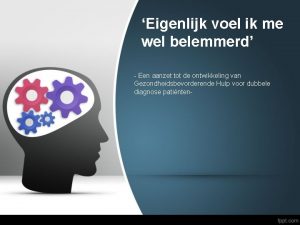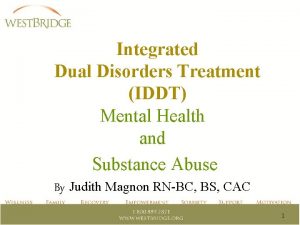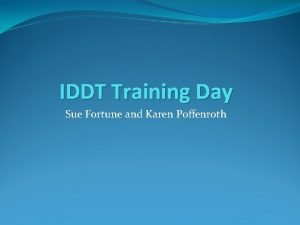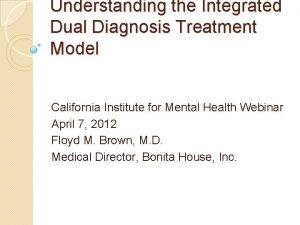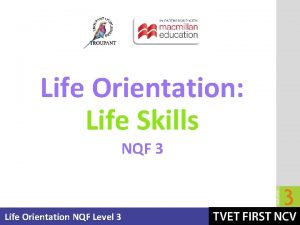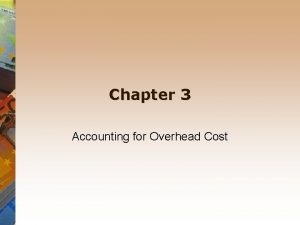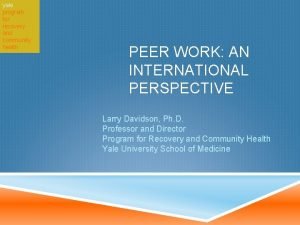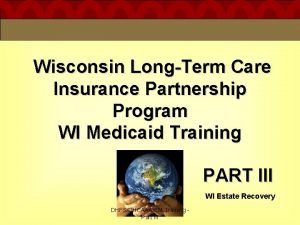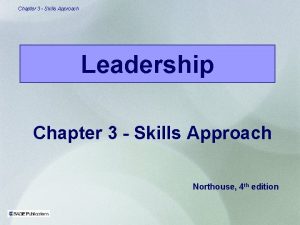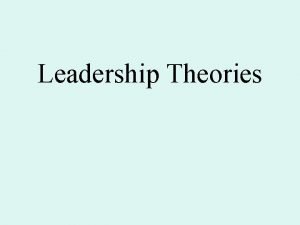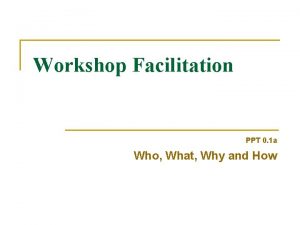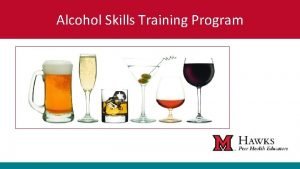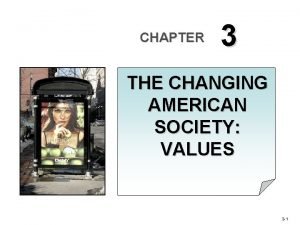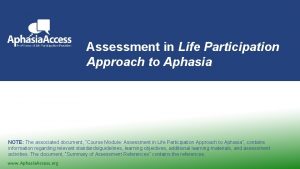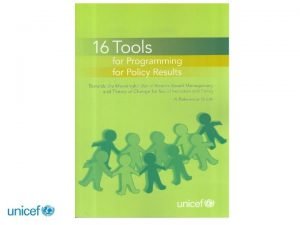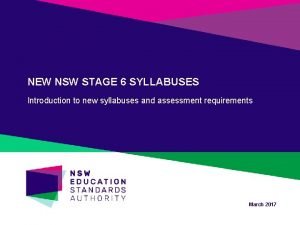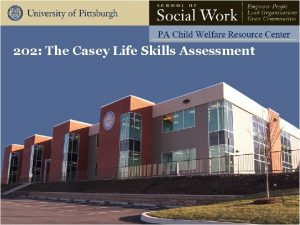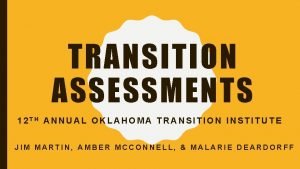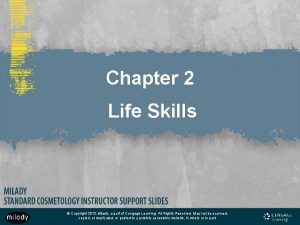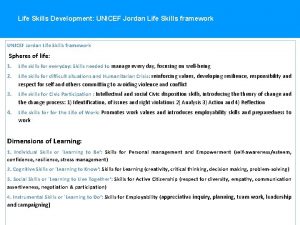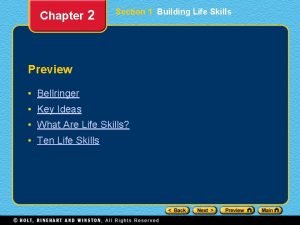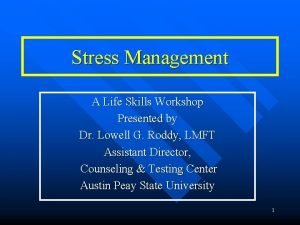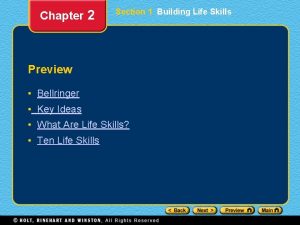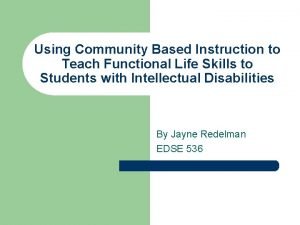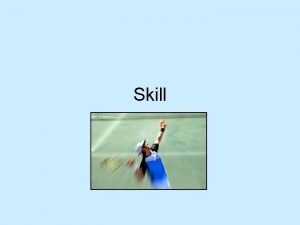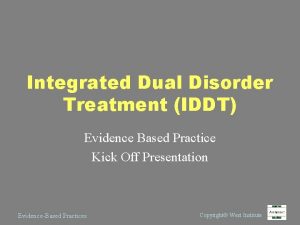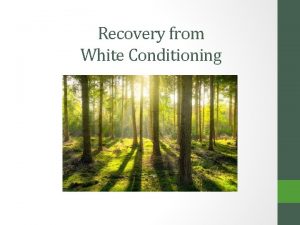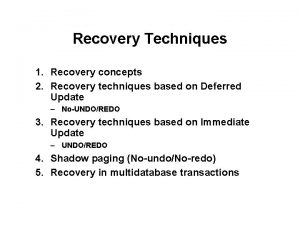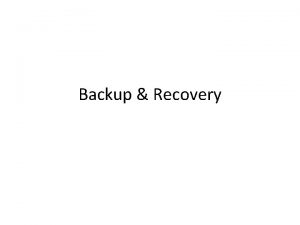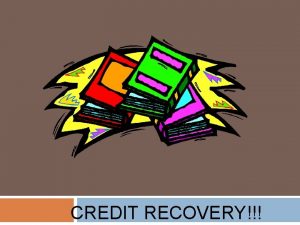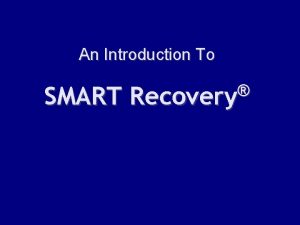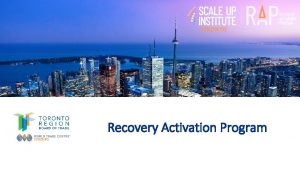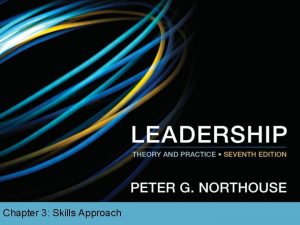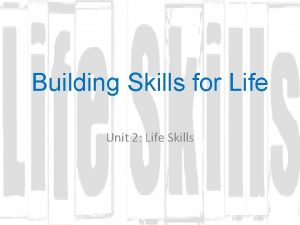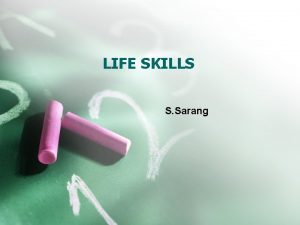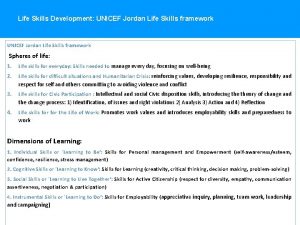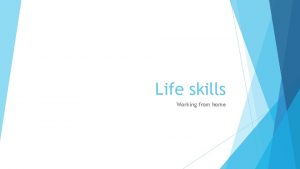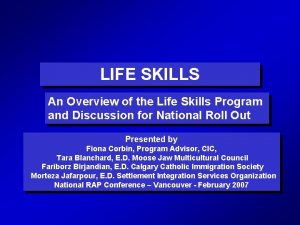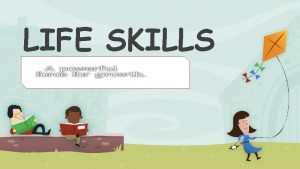IDDT Recovery Life Skills Program A GROUP APPROACH


























































- Slides: 58

IDDT Recovery Life Skills Program A GROUP APPROACH TO RELAPSE PREVENTION AND HEALTHY LIVING

Objectives Provide an overview of critical issues related to planning and conducting group interventions Explore theoretical framework of Recovery Life Skills and Integrated Dual Diagnosis Treatment (IDDT) Introduce session outlines for Recovery Life Skills group curriculum


Reflection Questions (Unmute) Some questions to think about: What is your experience with group interventions. How familiar are you with conducting group interventions? What do you like most about conducting groups? What challenges do you have while conducting groups?

FORMAT follows FUNCTION Psycho-educational: Dissemination of information, didactic Skills-training: Instructional, experiential Process: Insight oriented, focus on group dynamics Support: Mutual responsibility, focus on community Diagnostic Specific: PTSD, Depression, Anxiety, Substance Use Theoretically-Oriented: DBT, CBT, MI, ACT Setting Specific: inpatient, outpatient, drop-in

The Recovery Life Skills Program is Psycho-Educational Motivational Interviewing Substance Abuse Counseling Cognitive Behavioral

The Recovery Life Skills Program Duration: Flexible: 18 sessions can be broken up into 36 sessions Frequency: Flexible: 1 -2 sessions/week Session Length: 60 minutes Membership: open with pre-meetings with new members; closed Group size: 6 -8 members Client Characteristics: adults, co-occurring, active treatment, relapse prevention


Reflection Questions Think of any group you have been a part of (book club, peer support, exercise). What are characteristics of an effective group leader? List behaviors you think are essential for group leadership. What are some signs of a healthy, functioning group? List behaviors you would observe in a healthy, functioning group.

Characteristics of Effective Group Leaders Supports: The development of individual goals in a group setting The group in developing it’s own identity Group members in collaborating, sharing, decision-making Provides: Structure, direction, and guidance Instruction in a safe, stable learning environment A model for flexibility, an openness to feedback, and a curiosity for inquiry Empowers: Group members to take on roles within the group Individuals to develop skills

Recovery Life Skills Facilitators: May be new to Co-occurring Disorders Must be knowledgeable about COD, Substance Abuse Counseling, and peer recovery support groups. Warm and friendly while able to set healthy, firm boundaries Skilled in group facilitation, motivational interviewing, and social skills training Are responsible for communicating with the treatment team on client progress May choose to co-facilitate for any number of reasons (role-plays, continuity)

Group Member Eligibility Prospective Group Members: Co-occurring mental health and substance use disorder Active treatment (not using substances; stable mental health) Relapse Prevention Commitment to sobriety Desire to learn new skills Set goals to support lifestyle change ****Relapse can be accommodated for once stabilization is achieved and abstinence is committed to.

Pre-Group Interviews

Setting the Stage for Success: Pre-Group Interviews q. Allows for rapport to be built q. Clarification of group purpose, format, goals, homework q. Address questions/concerns q. Ensure client is in the appropriate stage of treatment for the group q. Catch client up on Orientation and Goal Identification q. Address learning/literacy concerns for accommodations q. Explain policy for relapse -slip and recommit -relapse and refuse to commit -recommit and return -stabilize and return


Goal Setting Activity: Consider a goal you have regarding a lifestyle change. Write down your goal in behavioral terms (observable, measurable, achievable). Write down the steps you are taking or plan to take towards your goal. What are some of the small steps you are taking towards your goal? What is one thing you plan to do towards your goal this week? Share with your group members.

Reflection Questions: What did you notice about your commitment to your goal when you wrote it down? How about when you shared it with your group members? For those of you actively working on a goal, how have you handled slips? For those of you planning on working on a goal, what needs to be in place before you can begin the work?

Integrated Dual Diagnosis Treatment for Individuals with Co-Occurring Disorders

Definition of Terms

Co-Occurring Disorders refers to co-occurring substance use and mental health disorders. Often referred to as COD. Other terms have been used -MICA, MISA, SAMI, ICOPSD, Dual Diagnosis

A Client with Co-occurring Disorders has one or more substance use disorder and one or more mental health disorders.

Diagnosis of Co-occurring Disorders occurs when the diagnostic criteria for a mental health disorder and a substance use disorder are independently met and are not simply a cluster of symptoms that resulting from only one disorder. Substance induced psychosis is not also schizophrenia. Anxiety resulting from methamphetamine use is not also panic disorder.

Reflection Questions as Clinician Consider your experience working with individuals with cooccurring substance use and mental health issues. What are some of your assumptions about individuals with COD? (Unmute) What are some of the key issues you have identified as essential for successful treatment and recovery for individuals with COD? (Unmute)

Prevalence Rates of Co-occurring Disorders 1: 5 adults with any mental illness also meet criteria for substance use dependence (19. 7 percent of all adults with any mental illness) 1: 4 adults with serious mental illness and substance use dependence (25. 7 percent of all adults with serious mental illness) 1: 2 adults with substance use disorder, (42. 8 percent) had co-occurring mental illness 2009 NATIONAL SURVEY ON DRUG USE AND HEALTH (NSDUH) ON THE NUMBER OF INDIVIDUALS IN THE UNITED STATES EXPERIENCING CO-OCCURRING MENTAL AND SUBSTANCE USE DISORDERS.

Historical Perspective Treatment has often been separate. Individuals with the most severe mental health and severe substance use disorders were unable to access adequate treatment in either service delivery system. SUD precluded an individual receiving MH treatment needs may have restricted access to some SUD treatment options.

Falling Through the Cracks

Traditional Treatment Models SEQUENTIAL TREATMENT PARALLEL TREATMENT Lack of clarity around which disorder to treat first Services are not integrated Untreated disorder worsens treated disorder Unclear when on disorder is “successfully treated” Client doesn’t get referred for necessary treatment Providers do not communicate Burden of integration falls upon the client No one accepts responsibility for the client Lack of common language or methodology INTEGRATED DUAL DIAGNOSIS TREATMENT, HAZELDEN, 2010 (PG. 12)

Access to Treatment Of 8. 9 million adults with any mental illness and a substance use disorder Access to Treatment No tx 40% SUD or MH 46% COD 14% 2009 NATIONAL SURVEY ON DRUG USE AND HEALTH (NSDUH) ON THE NUMBER OF INDIVIDUALS IN THE UNITED STATES EXPERIENCING CO-OCCURRING MENTAL AND SUBSTANCE USE DISORDERS.

Access to Treatment Serious Mental Illness and Substance Use Disorder No Treatment 40% Treatment for MH/SUD 60%

No Wrong Door

Severity of substance disorder The Four Quadrants of Behavioral Health Quadrant III. Less severe mental disorder/more severe substance disorder. SUD Treatment Provider Residential, IOP, Outpatient SUD Tx, Medically Managed Detox and Maintenance to Peer Recovery Quadrant IV. More severe mental disorder/more severe substance disorder. Integrated Co-Occurring Care Incarceration, IDDT, Inpatient Stabilization to Assertive Community Treatment Quadrant I. Less severe mental disorder/less severe substance disorder. Primary Care SBIRT, Prevention, Education, Medication Management Quadrant II. More severe mental disorder/less severe substance disorder. Community Mental Health Intensive Outpatient Programming to Peer Recovery Severity of mental health disorder CENTER FOR SUBSTANCE ABUSE AND TREATMENT (CSAT) TREATMENT IMPROVEMENT PROTOCOL, TIP 42

Integrated Treatment

Different Types of Integrated Treatment One clinician provides an array of needed services. Two or more clinicians work together to provide needed services. Clinician may consult with specialists and integrate consultation into care provided. Clinician may coordinate an array of services on an individual treatment plan that integrates services. One program (PACT) can provide integrated care. Multiple agencies can join together to create a program that serves a specific population.

Vision of Fully Integrated Treatment üOne program treats both disorders üOne clinician treats both disorders üAll clinicians trained in psychopathology, assessment, and treatment for both disorders üTailored SUD treatment for SPMI population üTreatment is characterized by a slow pace and long-term perspective üStage-wise and motivational counseling is available ü 12 -step groups are available üRecovery from both disorders üPharmacotherapies are indicated according to psychiatric and other medical needs.

Individuals with co-occurring disorders are more likely to experience: § Psychiatric episodes § Use, abuse, and relapse to alcohol and other drugs § Hospitalization and emergency room visits § Relationship difficulties § Violence § Suicide § Arrest and incarceration § Unemployment § Homelessness § Poverty § Infectious diseases, such as HIV, hepatitis, and sexually transmitted diseases § Complications resulting from chronic illnesses such as diabetes and cancer HTTP: //WWW. CENTERFOREBP. CASE. EDU/PRACTICES/SAMI/IDDT

Integrated Dual Diagnosis Treatment Increases Reduces §Continuity of care §Consumer quality-of-life outcomes §Stable housing §Independent living §Relapse of substance abuse and mental illness §Hospitalization §Arrest §Incarceration §Duplication of services §Service costs §Utilization of high-cost services HTTP: //WWW. CENTERFOREBP. CASE. EDU/PRACTICES/SAMI/IDDT

Integrated Dual Diagnosis Treatment Shared Decision Making Integration of Services Comprehensiveness Assertive Community Outreach Reduction of Negative Consequences Long-term Perspective Motivation-Based Treatment Multiple Psychotherapeutic Interventions IDDT MANUAL, DARTMOUTH, PG. 13

Shared Decision Making Client-centered/family-centered care Goals, treatment course, path Client, team, support network History, values, preferences Combine expertise of personal and professional Satisfaction with treatment increases

Integration of Services Both disorders are treated by one person or a team One treatment plans with shared responsibility One set of goals One relapse plan The key to knowing if care has been successfully integrated….

Comprehensiveness Goal to increase psychosocial support Housing Case management Supported employment Family psycho-education Social skills training Illness management Pharmacological treatment

Assertive Community Outreach Engages with clients where they are Increases access Community case management Homeless shelters Mobile Crisis Outreach Teams Jail Diversion Programs ACT Provides for immediate basic needs first Connects to stabilizing supports Case load ratio 1: 15 -30

Reduction of Negative Consequences Harm reduction Small steps before engaging in full recovery Allows client to make progress without all or nothing approach Increases motivation towards recovery

Long-term Perspective Paths to recovery vary There is no predetermined length of time Recovery is multifaceted Non-linear approach Client driven view point

Motivation-based Treatment Stage of change -Precontemplation -Contemplation -Preparation -Action -Maintenance Stage of treatment -Engagement -Persuasion -Active Treatment -Relapse Prevention

Multiple Therapeutic Approaches and Considerations Interventions must be individualized Goals, values, stage of change, stage of treatment Intensity of needs Severity and persistence Functioning Impairments Family Involvement Peer Supports Trauma Cultural Differences Employment, Parenting, Health

Let’s Talk about Recovery

Reflection Questions: What is your definition of recovery? (unmute) What is needed for an individual to achieve recovery? (unmut) How does your definition of recovery inform your work with individuals with chronic, recurring, disabling conditions such as serious and persistent mental illness and/or addictions?

Recovery from SAMHSA’s Perspective Working definition of recovery from mental disorders and/or substance use disorders “A process of change through which individuals improve their health and wellness, live a selfdirected life, and strive to reach their full potential. ” Health Overcoming or managing one’s disease(s) or symptoms—for example, abstaining from use of alcohol, illicit drugs, and nonprescribed medications if one has an addiction problem— and for everyone in recovery, making informed, healthy choices that support physical and emotional wellbeing. Home A stable and safe place to live Purpose Meaningful daily activities, such as a job, school, volunteerism, family caretaking, or creative endeavors, and the independence, income and resources to participate in society Community Relationships and social networks that provide support, friendship, love, and hope HTTP: //STORE. SAMHSA. GOV/SHIN/CONTENT//PEP 12 -RECDEF. PDF

10 Guiding Principles of Recovery Hope Relational Person-Driven Culture Many Pathways Addresses Trauma Holistic Strengths/Responsibility Peer Support Respect HTTP: //STORE. SAMHSA. GOV/SHIN/CONTENT//PEP 12 -RECDEF. PDF

IDDT Recovery Life Skills Program A GROUP APPROACH TO RELAPSE PREVENTION AND HEALTHY LIVING

Keys to Session Outlines jwhieuhfiufkjed kdklisihdiisyfhd snhkdnchikdhoi The shaded text in the session outlines is a script and is a suggestion for what you might say directly to the group. It is not intended to be read out loud verbatim. This icon indicates when group discussion should occur. When this icon precedes shaded script, it is a reminder that you are to engage with the group at this point in the session, addressing them directly and inviting group interaction and discussion. This icon reminds you to record important group comments and thoughts on the board (blackboard or white board). At the end of each session outline, you will find a reminder to transfer what you have written on the board onto the Recovery Life Skills Program Group Record for Facilitators (available on the CD-ROM or in the three-ring binder).

5 Step Session Step 1: Welcome and Check-in: 15 minutes Step 2: Review Previous Session: 10 minutes Step 3: Topic Discussion: 15 minutes Step 4: Personal Recovery Plan Worksheet and Goals: 15 minutes Step 5: Home Assignment: 5 minutes

Step 1: Welcome and Check-in: 15 minutes 1. On the board, write the topic for the session and the names of the facilitators. 2. Write the affirmation, the check-in questions, and the group guidelines, or display the poster board that contains this information already written. “I can’t always choose what happens to me, but I can choose what I do about it. ” 3. Review the group guidelines that were established during session 1. 4. Hand out the Personal Recovery Plan Worksheets and then ask for volunteers to answer the check-in questions. 5. Review the coping strategy they will use until the next session. 6. Record the responses onto your Recovery Life Skills Program Group Record for Facilitators. 7. Look over the answers recorded on the board and summarize the common patterns since the last session.

Step 2: Review Previous Session: 10 minutes 1. Ask group members what they remember about the last session’s topic. You may need to remind members of the session title to jog their memory. Ask a few open-ended questions regarding their understanding of the topic. 2. Review the home assignment from the last session. Take the time needed; address any incomplete work to emphasize importance. Record answers to homework on board. 3. Ask for a volunteer to share one thing they did on their home assignment. 4. Distribute the handouts for the current session.

Step 3: Topic Discussion: 15 minutes 1. Reference the individual session outlines in the facilitator manual for specific information and advice on leading the topic discussion. Take the time you need to cover the topic. 2. Each topic in the program has a group member handout linked with it. 3. Sometimes you will spend a lot of time on the topic, and other times, you may spend more time on other elements of the session, such as the review. 4. There is no one right way to conduct a session, other than to engage with the group and follow their lead.

Step 4: Personal Recovery Plan Worksheet and Goals: 15 minutes 1. Ask group members to take out their Personal Recovery Plan Worksheet and their Recovery Life Skills Worksheet for the session. 2. As the facilitator, you will hand out Personal Recovery Plan Worksheets during every session. 3. Ask what progress they have made on their goal since you last met. Problem-solve around no progress 4. Give members 10 minutes to fill out their worksheets, depending on how you are structuring your session. 5. After they have finished, ask them to share their answers to your questions on this session’s topic. 6. Make a copy of each one and keep them in a separate folder for each group member. Encourage members to store the originals in one place (a folder or a three-ring binder work well).

Step 5: Home Assignment: 5 minutes 1. Tell members what their home assignment is for the session. 2. Encourage group members to get people in their support network involved in their home assignments as much as possible to support them in their efforts and to help them practice new skills. 3. Check in with two group members about the progress they are making on their goals and ask whether they have accomplished any of their short-term goals. 4. Ask group members to choose one of their short-term goals to work on until the next session. 5. Remind members of the satisfaction they’ll receive from crossing one of their short-term goals off their list, once they have accomplished it. 6. Ask the group if there any questions or comments.

Questions? Comments? Remarks?
 Iddt methodiek
Iddt methodiek Ken minkoff
Ken minkoff Iddt training
Iddt training Dual treatment model
Dual treatment model Life skills approach
Life skills approach Joining together group theory and group skills
Joining together group theory and group skills Life orientation skills
Life orientation skills How to calculate oar
How to calculate oar Recovery sistem
Recovery sistem Disaster recovery audit program isaca
Disaster recovery audit program isaca Yale program for recovery and community health
Yale program for recovery and community health Estate recovery wisconsin
Estate recovery wisconsin Celebrate recovery lesson 14
Celebrate recovery lesson 14 Difference between datagram and virtual circuit approach
Difference between datagram and virtual circuit approach Cognitive approach vs behavioral approach
Cognitive approach vs behavioral approach Shower approach
Shower approach Multi approach avoidance conflict
Multi approach avoidance conflict Cognitive approach vs behavioral approach
Cognitive approach vs behavioral approach What is research approach definition
What is research approach definition Traditional approach to systems implementation
Traditional approach to systems implementation Tony wagner's seven survival skills
Tony wagner's seven survival skills Skills approach leadership
Skills approach leadership Leadership skills are defined in the chapter as
Leadership skills are defined in the chapter as Approach style
Approach style Interpersonal skills vs intrapersonal skills
Interpersonal skills vs intrapersonal skills Hard skills soft skills
Hard skills soft skills Skills passport
Skills passport Group managerial approach in classroom management
Group managerial approach in classroom management Virtual facilitation skills ppt
Virtual facilitation skills ppt Stop and think social skills program
Stop and think social skills program Alcohol skills training program
Alcohol skills training program Americans continue to value an active approach to life.
Americans continue to value an active approach to life. Asha qcl
Asha qcl Rbm life cycle
Rbm life cycle Stress management life skills
Stress management life skills Life skills e competenze chiave
Life skills e competenze chiave Life skills outcomes stage 6
Life skills outcomes stage 6 Benefits of hfle
Benefits of hfle Differenza tra competenze chiave e life skills
Differenza tra competenze chiave e life skills Characteristics of life skills
Characteristics of life skills Generic life skills
Generic life skills Casey life skills curriculum
Casey life skills curriculum Casey life skills assessment scoring
Casey life skills assessment scoring Milady life skills
Milady life skills St century
St century Life skills for kids
Life skills for kids Unicef life skills framework
Unicef life skills framework Objective of life skills
Objective of life skills Life skills chapter 2
Life skills chapter 2 Revised curriculum and assessment plans 2021
Revised curriculum and assessment plans 2021 Good life skills
Good life skills Stress management life skills
Stress management life skills Life skills chapter 2
Life skills chapter 2 Life skills definition
Life skills definition Ministry of education
Ministry of education Definition of life skills
Definition of life skills Chapter 2 skills for a healthy life
Chapter 2 skills for a healthy life Social psychology chapter 13
Social psychology chapter 13 Y = a(b)^x
Y = a(b)^x
